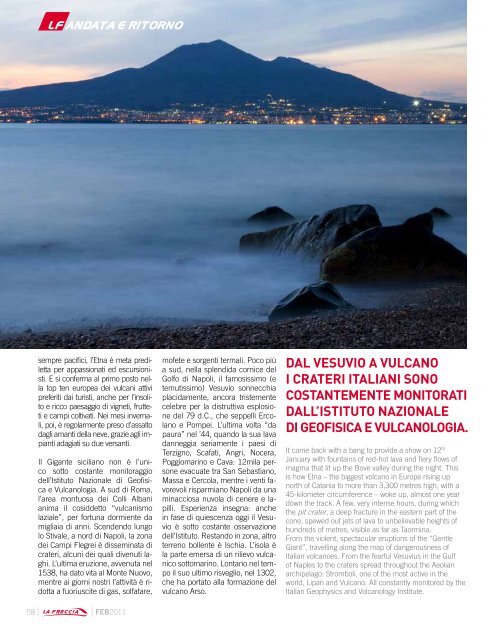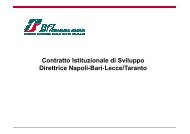pdf 18834 KB - FSNews
pdf 18834 KB - FSNews
pdf 18834 KB - FSNews
You also want an ePaper? Increase the reach of your titles
YUMPU automatically turns print PDFs into web optimized ePapers that Google loves.
ANDATA E RITORNO<br />
sempre pacifici, l’Etna è meta prediletta<br />
per appassionati ed escursionisti.<br />
E si conferma al primo posto nella<br />
top ten europea dei vulcani attivi<br />
preferiti dai turisti, anche per l’insolito<br />
e ricco paesaggio di vigneti, frutteti<br />
e campi coltivati. Nei mesi invernali,<br />
poi, è regolarmente preso d’assalto<br />
dagli amanti della neve, grazie agli impianti<br />
adagiati su due versanti.<br />
Il Gigante siciliano non è l’unico<br />
sotto costante monitoraggio<br />
dell’Istituto Nazionale di Geofisica<br />
e Vulcanologia. A sud di Roma,<br />
l’area montuosa dei Colli Albani<br />
anima il cosiddetto “vulcanismo<br />
laziale”, per fortuna dormiente da<br />
migliaia di anni. Scendendo lungo<br />
lo Stivale, a nord di Napoli, la zona<br />
dei Campi Flegrei è disseminata di<br />
crateri, alcuni dei quali divenuti laghi.<br />
L’ultima eruzione, avvenuta nel<br />
1538, ha dato vita al Monte Nuovo,<br />
mentre ai giorni nostri l’attività è ridotta<br />
a fuoriuscite di gas, solfatare,<br />
58 FEB2011<br />
mofete e sorgenti termali. Poco più<br />
a sud, nella splendida cornice del<br />
Golfo di Napoli, il famosissimo (e<br />
temutissimo) Vesuvio sonnecchia<br />
placidamente, ancora tristemente<br />
celebre per la distruttiva esplosione<br />
del 79 d.C., che seppellì Ercolano<br />
e Pompei. L’ultima volta “da<br />
paura” nel ’44, quando la sua lava<br />
danneggia seriamente i paesi di<br />
Terzigno, Scafati, Angri, Nocera,<br />
Poggiomarino e Cava: 12mila persone<br />
evacuate tra San Sebastiano,<br />
Massa e Cercola, mentre i venti favorevoli<br />
risparmiano Napoli da una<br />
minacciosa nuvola di cenere e lapilli.<br />
Esperienza insegna: anche<br />
in fase di quiescenza oggi il Vesuvio<br />
è sotto costante osservazione<br />
dell’Istituto. Restando in zona, altro<br />
terreno bollente è Ischia. L’isola è<br />
la parte emersa di un rilievo vulcanico<br />
sottomarino. Lontano nel tempo<br />
il suo ultimo risveglio, nel 1302,<br />
che ha portato alla formazione del<br />
vulcano Arso.<br />
DAL VESUVIO A VULCANO<br />
I CRATERI ITALIANI SONO<br />
COSTANTEMENTE MONITORATI<br />
DALL’ISTITUTO NAZIONALE<br />
DI GEOFISICA E VULCANOLOGIA.<br />
It came back with a bang to provide a show on 12 th<br />
January with fountains of red-hot lava and fiery flows of<br />
magma that lit up the Bove valley during the night. This<br />
is how Etna – the biggest volcano in Europe rising up<br />
north of Catania to more than 3,300 metres high, with a<br />
45-kilometer circumference – woke up, almost one year<br />
down the track. A few, very intense hours, during which<br />
the pit crater, a deep fracture in the eastern part of the<br />
cone, spewed out jets of lava to unbelievable heights of<br />
hundreds of metres, visible as far as Taormina.<br />
From the violent, spectacular eruptions of the “Gentle<br />
Giant”, travelling along the map of dangerousness of<br />
Italian volcanoes. From the fearful Vesuvius in the Gulf<br />
of Naples to the craters spread throughout the Aeolian<br />
archipelago: Stromboli, one of the most active in the<br />
world, Lipari and Vulcano. All constantly monitored by the<br />
Italian Geophysics and Volcanology Institute.

















